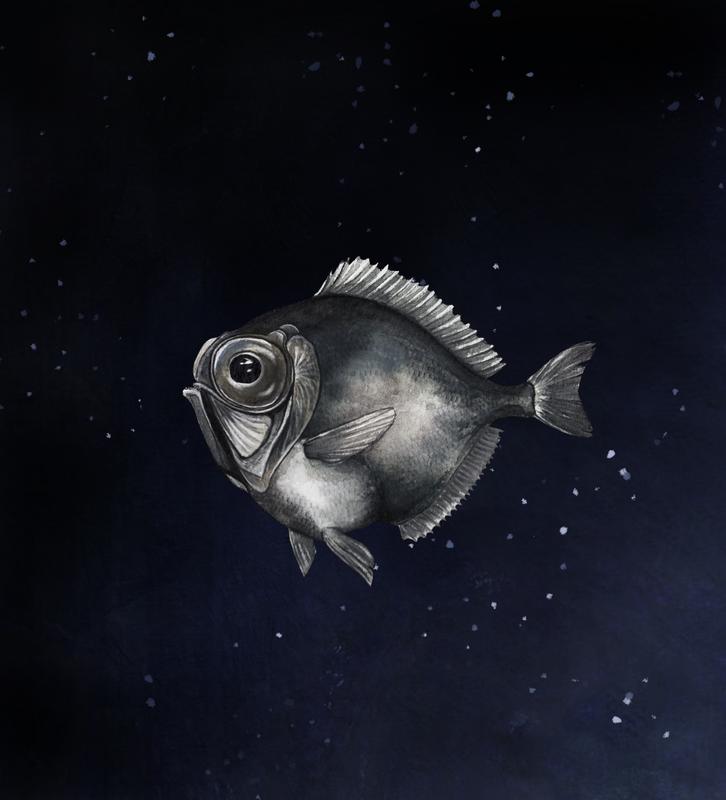New type of highly sensitive vision discovered in deep-sea fish

The silver spinyfin (Diretmus argenteus) is the vertebrate with the highest number of opsin genes. Alexandra Viertler, University of Basel
Color vision in vertebrates is usually achieved through the interaction of various photopigments in the cone cells found in the retina. Each of these photopigments reacts to a certain wavelength of light. In humans, for example, these wavelengths are the red, green and blue range of the light spectrum.
Color vision is only possible in daylight, however. In darkness, vertebrates detect the few available light particles with their light-sensitive rod cells, which contain only a single type of the photopigment rhodopsin – explaining why nearly all vertebrates are color-blind at night.
A genetic record for the silver spinyfin
An international team of researchers lead by Professor Walter Salzburger from the University of Basel recently analyzed more than 100 fish genomes, including those of fish living in deep-sea habitats. The zoologists discovered that certain deep-sea fish have expanded their repertoire of rhodopsin genes.
In the case of the silver spinyfin (Diretmus argenteus), they found no less than 38 copies of the rhodopsin gene, in addition to two other opsins of a different type. “This makes the darkness-dwelling silver spinyfin the vertebrate with the most photopigment genes by far,” explains Salzburger.
The deep-sea fish’s many different rhodopsin gene copies have each adapted to detect a certain wavelength of light, the researchers further reported. They demonstrated this through computer simulations and functional experiments on rhodopsin proteins regenerated in the lab.
The genes cover exactly the wavelength range of light “produced” by light-emitting organs of deep-sea organisms. This is known as bioluminescence, which is the ability of an organism to produce light on its own or with the help of other organisms. For example, anglerfish attract prey with their bioluminescent organs.
Detecting signals in the dark
The deep sea is the largest habitat on Earth and yet one of the least explored due to its inaccessibility. Many organisms have adapted to life in the near-total darkness of this inhospitable environment. For example, many fish have developed highly sensitive telescope eyes that allow them to detect the tiny amount of residual light that makes it to the depths of the ocean.
In vertebrates, 27 key spectral tuning sites have been identified in the protein for rhodopsin. These sites directly affect which wavelengths are detected. The researchers discovered that in the various gene copies of the deep-sea silver spinyfin, 24 of these positions exhibited mutations.
“It appears that deep-sea fish have developed this multiple rhodopsin-based vision several times independently of each other, and that this is specifically used to detect bioluminescent signals,” says Salzburger. He adds that this may give deep-sea fish an evolutionary advantage by allowing them to much better see potential prey or predators.
“In any case, our findings help redefine the current paradigm of vertebrate vision in terms of the role of rod photoreceptors,” the zoologists write. This presents yet another instance in which analyzing whole genomes led to new biological discoveries.
Prof. Dr. Walter Salzburger, University of Basel, Department of Environmental Sciences, Zoology, Tel. +41 61 207 03 03, Email: walter.salzburger@unibas.ch
Zuzana Musilova, Fabio Cortesi, Michael Matschiner, Wayne I. L. Davies, Jagdish Suresh Patel, Sara M. Stieb, Fanny de Busserolles, Martin Malmstrøm, Ole K. Tørresen, Celeste J. Brown, Jessica K. Mountford, Reinhold Hanel, Deborah L. Stenkamp, Kjetill S. Jakobsen, Karen L. Carleton, Sissel Jentoft, Justin Marshall, Walter Salzburger
Vision using multiple distinct rod opsins in deep-sea fishes
Science (2019), doi: 10.1126/science.aav4632
https://science.sciencemag.org/lookup/doi/10.1126/science.aav4632
Media Contact
More Information:
http://www.unibas.chAll latest news from the category: Life Sciences and Chemistry
Articles and reports from the Life Sciences and chemistry area deal with applied and basic research into modern biology, chemistry and human medicine.
Valuable information can be found on a range of life sciences fields including bacteriology, biochemistry, bionics, bioinformatics, biophysics, biotechnology, genetics, geobotany, human biology, marine biology, microbiology, molecular biology, cellular biology, zoology, bioinorganic chemistry, microchemistry and environmental chemistry.
Newest articles

First-of-its-kind study uses remote sensing to monitor plastic debris in rivers and lakes
Remote sensing creates a cost-effective solution to monitoring plastic pollution. A first-of-its-kind study from researchers at the University of Minnesota Twin Cities shows how remote sensing can help monitor and…

Laser-based artificial neuron mimics nerve cell functions at lightning speed
With a processing speed a billion times faster than nature, chip-based laser neuron could help advance AI tasks such as pattern recognition and sequence prediction. Researchers have developed a laser-based…

Optimising the processing of plastic waste
Just one look in the yellow bin reveals a colourful jumble of different types of plastic. However, the purer and more uniform plastic waste is, the easier it is to…



